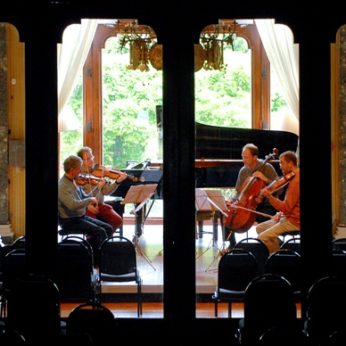Composer: Benjamin Britten (b. 1913 - d. 1976)
Performance date: 29/06/2013
Venue: St. Brendan’s Church
Composition Year: 1945
Duration: 00:28:48
Recording Engineer: Damian Chennells, RTÉ lyric fm
Instrumentation: 2vn, va, vc
Instrumentation Category:String Quartet
Artists:
RTÉ Vanbrugh Quartet (Gregory Ellis, Keith Pascoe [violins], Simon Aspell [viola], Christopher Marwood [cello]) -
[quartet]

This quartet was commissioned by Mary
Behrend, a notable patron of the arts, and was premiered in the Wigmore Hall in
November 1945, the day after Britten and Peter Pears had premiered his Holy Sonnets of John Donne. Both
concerts were part of the 250th anniversary celebrations of the
death of Purcell. For the previous six years, Britten and Pears had been
including Purcell in their recitals, with piano parts realised by Britten from
Purcell’s figured bass. His latest opera, Peter
Grimes, had been premiered earlier that year, and had demonstrated how much
Britten had learned from Purcell’s handling of words. He said afterwards that
when he had been composing the opera, he had had a quartet at the back of his
mind. Some commentators feel that the quartet is an instrumental sequel to the
opera, with its themes of isolation, persecution, hypocrisy and uncontrollable
violence. Auden famously wrote to Britten in 1942: If you are really to develop your full stature, you will have, I think,
to suffer and make others suffer, in ways which are totally strange to you at
present, and against every conscious value that you have. Peter Grimes was
the embodiment of this judgement.
Britten was notorious for not giving any
clues about his compositional process, but he chose Purcell’s Fantasia upon One Note as the filler on
the final side of the first recording of the quartet. It seems likely that the
drone of two sustained notes on the viola, which opens the work, is modelled on
that piece. In Britten’s harmonic language, the drone, which is on two notes
that imply a C major chord, probably represents a state of naturalness. Above
it is played a lyrical, slightly chromatic theme, which seems to suggest the
mind of the contemplative artist. As the movement progresses, it alternates
between feverish energy and exhaustion. The eerie central scherzo is very short
and is played on muted instruments. The Chacony,
at which Purcell was such a master, was a slow dance in triple metre, based on
a repeating pattern in the bass. Britten spins out 21 variations, in three sets
of six plus three at the end. The first set focuses on harmony, the second on
rhythmic variation, the third on new superimposed melodies. Each set is
followed by a cadenza for a single instrument, first cello, then viola, then
first violin. This is a huge movement of increasingly dramatic music, whose
immense power reflects the savagery of the opera.
Copyright © 2025 West Cork Music. All rights reserved.
Designed and developed by Matrix Internet